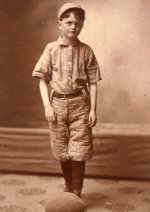
In the past I have been called many names. In the catalytically-related remarks I have been known as the Great White Father of Catalysis, the Dean of Catalysis, and the High Priest of the Witches' Brew called Catalysis. I am not sure of the complimentary significance of any of these in view of the general aversion to white hair, to some deans, and to concoctions known as "witches' brew." However, I have no doubt of the honor in receiving and the complimentary intent in presenting to me today the prestigious Chemical Pioneer award. I deeply appreciate being selected as one of the 1980 recipients.
Before proceeding with the brief recapitulation of my lifetime of catalytic research I want to emphasize that anything I may have accomplished and any credit that has been given me for my work in the field of catalysis would not have been possible without the expert assistance with which I have been blessed in the form of good graduate students, post-doctorates and research assistants. Their names are too numerous to mention here but to all of them I owe a vote of thanks. Their help has laid the experimental foundation for most of the research that I have published.
A word about how I became interested in chemistry and in catalysis is perhaps in order. A faculty counselor at Washington High School in Portland, Oregon, during my senior year advised me to pursue a technical career in science or engineering. At her suggestion I signed up for both physics and chemistry for the last term in high school. I took my chemistry under Dr. "Willie" Green, who had a reputation for inspiring students to become chemists. The well known and illustrious Linus Pauling was one of his students a year ahead of me.
After finishing a Chemical Engineering course at the Oregon Agricultural College (now Oregon State University) I went to the California Institute of Technology for my Ph.D. in physical chemistry. In conference with the head of the chemistry department, Dr. A. A. Noyes, I elected to work in the field of catalysis under Dr. Arthur F. Benton, who had just obtained his degree at Princeton University under Dr. H.S. Taylor, the Dean of Catalysis at that time in American, and even in international circles of science. Time has proved the choice of Dr. Benton as my research supervisor and catalysis as my field of research a fortunate one. Dr. Benton not only aroused my interest in catalysis but taught me all that was then known about the subject. I will have been in contact with the field of catalysis 58 years next September. And, let me add, I have enjoyed and am still enjoying every minute of it.
To summarize one's life work in a short talk is rather difficult. For the sake of simplicity I have grouped my work under four main headings: (1) Studies on the Catalytic Synthesis of Ammonia; (2) The Catalytic Synthesis of Hydrocarbons from Carbon Monoxide and Hydrogen—the Fischer-Tropsch Process; (3) Studies on the Cracking of Hydrocarbons over Silica-Alumina Catalysts and (4) Miscellaneous Catalytic and Surface Work. The synthetic ammonia research was carried out mostly at the Fixed Nitrogen Research Laboratory in Washington, D. C. during the eleven year period 1926-37, though some of it extended on through later periods of my life. The hydrocarbon synthesis and the catalytic cracking work were started at the Mellon Institute in Pittsburgh, Pa.,(1944-55) but were continued through the final 15 years at The Johns Hopkins University where I was W.R. Grace Professor of Chemistry. The miscellaneous research, including extensive studies on hydrogenation was done at The Johns Hopkins University partly in the Department of Chemical Engineering (1937-44), partly at the Mellon Institute and partly in the Chemistry Department at The Johns Hopkins University (1955-1970).


